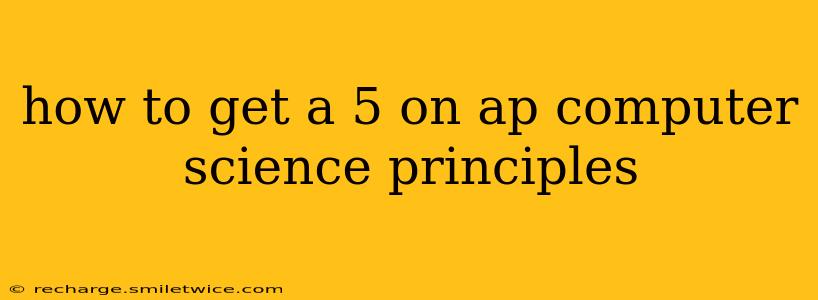How to Ace the AP Computer Science Principles Exam: A Comprehensive Guide
The AP Computer Science Principles (CSP) exam can seem daunting, but with the right approach and dedicated effort, achieving a 5 is entirely achievable. This guide provides a comprehensive roadmap to success, addressing common student concerns and offering practical strategies.
What is the AP Computer Science Principles Exam?
The AP CSP exam assesses your understanding of fundamental computer science concepts, not your coding proficiency. It focuses on computational thinking, algorithms, programming, the internet, data, and societal impacts of computing. The exam consists of two sections: a multiple-choice section and a free-response section, both testing your conceptual understanding.
How to Structure Your Study Plan:
A successful study plan hinges on consistent effort and a balanced approach. Here's a suggested structure:
- Understand the Exam Format: Familiarize yourself with the exam's structure, timing, and question types. Practice with past exams to get a feel for the pace and difficulty.
- Master the Core Concepts: The College Board's curriculum framework outlines the key topics. Focus on deeply understanding each, rather than superficial memorization.
- Create a Study Schedule: Develop a realistic schedule that incorporates regular review sessions and practice exams. Consistency is key. Don't cram!
- Utilize Multiple Resources: Don't rely solely on your textbook. Explore online resources, videos, and practice problems from various sources.
- Practice, Practice, Practice: The more you practice, the more confident and prepared you'll become. Focus on both multiple-choice and free-response questions.
Key Concepts to Focus On:
- Computational Thinking: Understand the process of breaking down complex problems into smaller, manageable parts. Practice creating algorithms and flowcharts.
- Data: Explore different types of data (numbers, text, images) and how they're represented and manipulated in a computer.
- Algorithms: Learn how to design, analyze, and implement algorithms to solve problems. Understand algorithm efficiency.
- Programming: While coding isn't the central focus, a basic understanding of programming concepts (variables, loops, conditionals) is essential. Experience with a block-based language like Blockly can be beneficial.
- Internet: Understand the fundamental concepts of the internet, including its architecture, protocols, and security.
- Impact of Computing: Explore the societal and ethical implications of technology, including issues of privacy, security, and accessibility.
H2: What are the best resources for studying for the AP Computer Science Principles exam?
The College Board website is your primary resource. It provides the curriculum framework, sample questions, and scoring guidelines. Supplement this with reputable online courses, practice tests from various publishers, and potentially a study group.
H2: How many practice exams should I take?
Aim for at least 3-5 full-length practice exams in the weeks leading up to the exam. This helps you simulate test conditions, identify weak areas, and refine your time management skills.
H2: What is the best way to prepare for the Create Performance Task (CPT)?
The CPT requires you to design, develop, and document a creative project using computational tools. Start early, brainstorm innovative ideas, clearly document your process, and ensure your project showcases your understanding of core concepts.
H2: How much coding is required for the AP CSP exam?
While coding isn't heavily tested, a fundamental understanding of programming concepts and the ability to interpret code snippets is crucial. Focus on the underlying logic and how code relates to the broader concepts.
H2: What are some common mistakes students make when preparing for the exam?
- Ignoring the free-response section: The free-response section carries significant weight. Don't neglect practice.
- Focusing solely on memorization: Deep understanding is key. Focus on applying concepts rather than rote memorization.
- Procrastination: Consistent study throughout the year is far more effective than cramming.
- Not seeking help when needed: Don't hesitate to ask your teacher or classmates for help if you're struggling with a topic.
By following this comprehensive guide, focusing on conceptual understanding, and practicing consistently, you significantly increase your chances of achieving a 5 on the AP Computer Science Principles exam. Remember that success is a journey, not a destination; stay dedicated, and you'll reach your goal!
